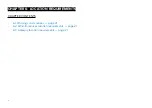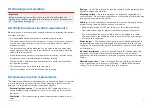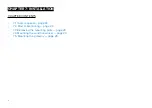
3.1 Product overview
The RSW-Wired is a short arm Smart Wind transducer system designed for
performance sailors.
The RSW-Wired Smart Wind transducer is a precision instrument, combining a
high performance AHRS 3D sensor with intelligent onboard data processing
— no external processing unit required. The integrated design provides a
greatly simplified installation and low-latency vane response times.
The RSW-Wired Smart Wind transducer has the following features:
• 3D sensor and Smart Wind technology deliver improved wind speed and
direction stability from tack to tack, by compensating for:
– Boat speed.
– Leeway.
– Mast twist and bend.
– Mast rotation.
– Dynamic vessel motion (pitch and roll).
– Sail effects (upwash calculations).
• Embedded 9-axis Attitude and Heading Reference System (AHRS) sensor:
–
gyro
operating on 3 axis.
–
accelerometer
operating on 3 axis.
–
magnetometer
operating on 3 axis.
• Highly accurate measurement of wind speed and direction — no calibration
tables needed.
• Precision design for increased accuracy.
• Lightweight arm design with rigid carbon construction.
• NMEA 2000 wired gateway included, for connection to SeaTalkng or
DeviceNet backbones.
3.2 Smart Wind Transducer compatibility
The Smart Wind transducer uses NMEA 2000 PGN 130306 to transmit wind
data to the network. Any Raymarine® or third party instrument display / MFD
(chartplotter) capable of receiving this PGN can display the Smart Wind
transducer’s wind data.
However, to benefit from the full range of features available with the Smart
Wind transducer, additional data sources are required.
Using the Smart Wind transducer in non-Raymarine systems
When using the Smart Wind transducer on an NMEA 2000 network which
contains only third-party (non-Raymarine®) equipment, the following list of
restrictions applies:
• Leeway and Sail effect (upwash calculation) corrections which are enabled
by default cannot be disabled.
• Rotating mast configuration settings which are disabled by default cannot
be enabled.
• In the scenario that no vessel heading data is available on your NMEA
2000 network (e.g. from a heading sensor) and your multifunction display
/ chartplotter is not able to apply a manual vane offset angle, the wind
transducer
must
be installed
directly on the mast centerline
. This is
because an offset angle cannot be applied to account for the difference
between the mast’s centerline and the wind transducer’s installation angle.
Note:
For a full list of NMEA 2000 PGNs transmitted by the Smart Wind
transducer, refer to:
p.67 — Supported NMEA2000 PGNs
Using the Smart Wind transducer in systems with Raymarine
displays
For optimum performance, the Smart Wind transducer can be partnered
with compatible Raymarine® displays:
13
Содержание RSW-Wired
Страница 2: ......
Страница 4: ......
Страница 16: ...CHAPTER 4 PARTS SUPPLIED CHAPTER CONTENTS 4 1 Parts supplied page 17 16...
Страница 36: ...CHAPTER 10 GROUND CONNECTION CHAPTER CONTENTS 10 1 Gateway ground connection page 37 36...
Страница 45: ...CHAPTER 13 MAINTENANCE CHAPTER CONTENTS 13 1 Service and maintenance page 46 Maintenance 45...
Страница 68: ......
Страница 71: ...WEEE Directive 8 What s in the box 17 Wind transducer Configuration 42 44 Wire stripping 39...
Страница 72: ......
Страница 73: ......




























